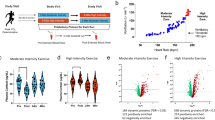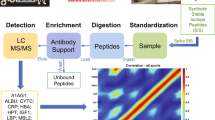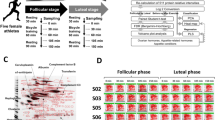Abstract
Maximal oxygen uptake (VO2max) is a direct measure of human cardiorespiratory fitness and is associated with health. However, the molecular determinants of interindividual differences in baseline (intrinsic) VO2max, and of increases of VO2max in response to exercise training (ΔVO2max), are largely unknown. Here, we measure ~5,000 plasma proteins using an affinity-based platform in over 650 sedentary adults before and after a 20-week endurance-exercise intervention and identify 147 proteins and 102 proteins whose plasma levels are associated with baseline VO2max and ΔVO2max, respectively. Addition of a protein biomarker score derived from these proteins to a score based on clinical traits improves the prediction of an individual’s ΔVO2max. We validate findings in a separate exercise cohort, further link 21 proteins to incident all-cause mortality in a community-based cohort and reproduce the specificity of ~75% of our key findings using antibody-based assays. Taken together, our data shed light on biological pathways relevant to cardiorespiratory fitness and highlight the potential additive value of protein biomarkers in identifying exercise responsiveness in humans.
This is a preview of subscription content, access via your institution
Access options
Access Nature and 54 other Nature Portfolio journals
Get Nature+, our best-value online-access subscription
$29.99 / 30 days
cancel any time
Subscribe to this journal
Receive 12 digital issues and online access to articles
$119.00 per year
only $9.92 per issue
Buy this article
- Purchase on Springer Link
- Instant access to full article PDF
Prices may be subject to local taxes which are calculated during checkout






Similar content being viewed by others
Data availability
Deidentified, individual-level proteomics and phenotypic data that support the HERITAGE findings within this paper are available at https://motrpac-data.org/related-studies/heritage-proteomics. Overlapping aptamer-based and antibody-based proteomics data on the HERITAGE sample are included Supplementary Data Table 1. GWAS summary statistics for FHS and JHS are available through restricted access via the database of Genotypes and Phenotypes (dbGaP), a publicly available resource developed to archive data from human studies of genotype–phenotype relationships and can be accessed here (https://www.ncbi.nlm.nih.gov/gap/; FHS accession number: phs000363.v19.p13; JHS accession number: phs000964). FHS proteomics data have also been deposited in dbGaP and are available through the same accession number. JHS proteomics data have been deposited in the JHS Data Coordinating Center and are being deposited in dbGaP (accession number: phs002256.v1.p1); pending its receipt in dbGaP, all JHS data are available from the JHS Data Coordinating Center on request (JHSccdc@umc.edu). In addition, proteogenetics findings (precise SNP IDs) included in Supplementary Table 15 from FHS/MDCS meta-analysis and JHS have been provided in Tables 2 and 3 in the Supplementary Data, respectively. Additional data supporting the findings of this study are available from the corresponding author upon reasonable request.
References
Hawley, J. A., Hargreaves, M., Joyner, M. J. & Zierath, J. R. Integrative biology of exercise. Cell 159, 738–749 (2014).
Hawkins, M. N., Raven, P. B., Snell, P. G., Stray-Gundersen, J. & Levine, B. D. Maximal oxygen uptake as a parametric measure of cardiorespiratory capacity. Med. Sci. Sports Exerc. 39, 103–107 (2007).
Ross, R. et al. Importance of assessing cardiorespiratory fitness in clinical practice: a case for fitness as a clinical vital sign: a scientific statement from the american heart association. Circulation 134, e653–e699 (2016).
Myers, J. et al. Exercise capacity and mortality among men referred for exercise testing. N. Engl. J. Med. 346, 793–801 (2002).
Mora, S. et al. Ability of exercise testing to predict cardiovascular and all-cause death in asymptomatic women: a 20-year follow-up of the lipid research clinics prevalence study. JAMA 290, 1600–1607 (2003).
Blair, S. N. et al. Changes in physical fitness and all-cause mortality. A prospective study of healthy and unhealthy men. JAMA 273, 1093–1098 (1995).
Clausen, J. S. R., Marott, J. L., Holtermann, A., Gyntelberg, F. & Jensen, M. T. Midlife cardiorespiratory fitness and the long-term risk of mortality: 46 years of follow-p. J. Am. Coll. Cardiol. 72, 987–995 (2018).
di Prampero, P. E. & Ferretti, G. Factors limiting maximal oxygen consumption in humans. Respir. Physiol. 80, 113–127 (1990).
González-Alonso, J. & Calbet, J. A. Reductions in systemic and skeletal muscle blood flow and oxygen delivery limit maximal aerobic capacity in humans. Circulation 107, 824–830 (2003).
Wagner, P. D. CrossTalk proposal: diffusion limitation of O2 from microvessels into muscle does contribute to the limitation of V̇O2max. J. Physiol. 593, 3757–3758 (2015).
Joyner, M. J. & Coyle, E. F. Endurance exercise performance: the physiology of champions. J. Physiol. 586, 35–44 (2008).
Bouchard, C. et al. Familial resemblance for VO2max in the sedentary state: the HERITAGE family study. Med. Sci. Sports Exerc. 30, 252–258 (1998).
Skinner, J. S. et al. Age, sex, race, initial fitness, and response to training: the HERITAGE Family Study. J. Appl. Physiol. 90, 1770–1776 (2001).
Williams, C. J. et al. Genes to predict VO. BMC Genomics 18, 831 (2017).
Sarzynski, M. A., Ghosh, S. & Bouchard, C. Genomic and transcriptomic predictors of response levels to endurance exercise training. J. Physiol. 595, 2931–2939 (2017).
Lewis, G. D. et al. Metabolic signatures of exercise in human plasma. Sci. Transl. Med. 2, 33ra37 (2010).
Overmyer, K. A. et al. Maximal oxidative capacity during exercise is associated with skeletal muscle fuel selection and dynamic changes in mitochondrial protein acetylation. Cell Metab. 21, 468–478 (2015).
Wewer Albrechtsen, N. J. et al. Plasma proteome profiling reveals dynamics of inflammatory and lipid homeostasis markers after Roux-En-Y gastric bypass surgery. Cell Syst. 12, 601–612(2018).
Jacob, J. et al. Application of large scale aptamer-based proteomic profiling to ‘planned’ myocardial infarctions. Circulation 137, 1270–1277 (2017).
Gold, L. et al. Aptamer-based multiplexed proteomic technology for biomarker discovery. PLoS ONE 5, e15004 (2010).
Kim, C. H. et al. Stability and reproducibility of proteomic profiles measured with an aptamer-based platform. Sci. Rep. 8, 8382 (2018).
Williams, S. A. et al. Plasma protein patterns as comprehensive indicators of health. Nat. Med. 25, 1851–1857 (2019).
Ross, R., Hudson, R., Stotz, P. J. & Lam, M. Effects of exercise amount and intensity on abdominal obesity and glucose tolerance in obese adults: a randomized trial. Ann. Intern. Med. 162, 325–334 (2015).
St Hilaire, C. et al. NT5E mutations and arterial calcifications. N. Engl. J. Med. 364, 432–442 (2011).
Hasnain, S. Z. et al. Glycemic control in diabetes is restored by therapeutic manipulation of cytokines that regulate beta cell stress. Nat. Med. 20, 1417–1426 (2014).
Lee, E. J. et al. Fibromodulin: a master regulator of myostatin controlling progression of satellite cells through a myogenic program. FASEB J. 30, 2708–2719 (2016).
Hynes, R. O. & Naba, A. Overview of the matrisome — an inventory of extracellular matrix constituents and functions. Cold Spring Harb. Perspect. Biol. 4, a004903 (2012).
Ngo, D. et al. Aptamer-based proteomic profiling reveals novel candidate biomarkers and pathways in cardiovascular disease. Circulation 134, 270–285 (2016).
Ko, D. et al. Proteomics profiling and risk of new-onset atrial fibrillation: Framingham Heart Study. J. Am. Heart Assoc. 8, e010976 (2019).
Emilsson, V. et al. Co-regulatory networks of human serum proteins link genetics to disease. Science 361, 769–773 (2018).
Whitham, M. et al. Extracellular Vesicles Provide a Means for Tissue Crosstalk during Exercise. Cell Metab. 27, 237–251.e4 (2018).
Whittle, A. J. et al. BMP8B increases brown adipose tissue thermogenesis through both central and peripheral actions. Cell 149, 871–885 (2012).
Pellegrinelli, V. et al. Adipocyte-secreted BMP8b mediates adrenergic-induced remodeling of the neuro-vascular network in adipose tissue. Nat. Commun. 9, 4974 (2018).
Seldin, M. M. et al. A strategy for discovery of endocrine interactions with application to whole-body metabolism. Cell Metab. 27, 1138–1155 (2018).
Karsenty, G. & Olson, E. N. Bone and muscle endocrine functions: unexpected paradigms of inter-organ communication. Cell 164, 1248–1256 (2016).
Santos-Parker, J. R., Santos-Parker, K. S., McQueen, M. B., Martens, C. R. & Seals, D. R. Habitual aerobic exercise and circulating proteomic patterns in healthy adults: relation to indicators of healthspan. J. Appl. Physiol. 125, 1646–1659 (2018).
Wang, C. Y. et al. Cardiorespiratory fitness levels among US adults 20-49 years of age: findings from the 1999–2004 national health and nutrition examination survey. Am. J. Epidemiol. 171, 426–435 (2010).
Swift, D. L. et al. Low cardiorespiratory fitness in African Americans: a health disparity risk factor? Sports Med. 43, 1301–1313 (2013).
Fleg, J. L. et al. Accelerated longitudinal decline of aerobic capacity in healthy older adults. Circulation 112, 674–682 (2005).
Abe, T., Loenneke, J. P. & Thiebaud, R. S. Fat-free adipose tissue mass: impact on peak oxygen uptake (VO2peak) in adolescents with obesity. Sports Med. 49, 9–15 (2019).
Bray, M. S. et al. The human gene map for performance and health-related fitness phenotypes: the 2006–2007 update. Med. Sci. Sports Exerc. 41, 35–73 (2009).
Timmons, J. A. et al. Using molecular classification to predict gains in maximal aerobic capacity following endurance exercise training in humans. J. Appl. Physiol. 108, 1487–1496 (2010).
Bouchard, C. et al. Genomic predictors of the maximal O2 uptake response to standardized exercise training programs. J. Appl. Physiol. 110, 1160–1170 (2011).
Ghosh, S. et al. Exploring the underlying biology of intrinsic cardiorespiratory fitness through integrative analysis of genomic variants and muscle gene expression profiling. J. Appl. Physiol. 126, 1292–1314 (2019).
Ghosh, S. et al. Integrative pathway analysis of a genome-wide association study of (V)O2max response to exercise training. J. Appl. Physiol. 115, 1343–1359 (2013).
Carvalho-Silva, D. et al. Open Targets Platform: new developments and updates two years on. Nucleic Acids Res. 47, D1056–D1065 (2018).
Lee, P. S. et al. Plasma gelsolin depletion and circulating actin in sepsis: a pilot study. PLoS ONE 3, e3712 (2008).
Lee, P. S. et al. Plasma gelsolin and circulating actin correlate with hemodialysis mortality. J. Am. Soc. Nephrol. 20, 1140–1148 (2009).
Egerstedt, A. et al. Profiling of the plasma proteome across different stages of human heart failure. Nat. Commun. 10, 5830 (2019).
Witke, W. et al. Hemostatic, inflammatory, and fibroblast responses are blunted in mice lacking gelsolin. Cell 81, 41–51 (1995).
Lee, W. M. & Galbraith, R. M. The extracellular actin-scavenger system and actin toxicity. N. Engl. J. Med. 326, 1335–1341 (1992).
Goetzl, E. J. et al. Gelsolin binding and cellular presentation of lysophosphatidic acid. J. Biol. Chem. 275, 14573–14578 (2000).
Li, G. H., Arora, P. D., Chen, Y., McCulloch, C. A. & Liu, P. Multifunctional roles of gelsolin in health and diseases. Med Res. Rev. 32, 999–1025 (2012).
Baird, G. S. & Hoofnagle, A. N. A novel discovery platform: aptamers for the quantification of human proteins. Clin. Chem. 63, 1061–1062 (2017).
Bouchard, C. et al. The HERITAGE family study. Aims, design, and measurement protocol. Med. Sci. Sports Exerc. 27, 721–729 (1995).
Skinner, J. S. et al. Heart rate versus %VO2max: age, sex, race, initial fitness, and training response — HERITAGE. Med. Sci. Sports Exerc. 35, 1908–1913 (2003).
Skinner, J. S. et al. Reproducibility of maximal exercise test data in the HERITAGE family study. Med. Sci. Sports Exerc. 31, 1623–1628 (1999).
Candia, J. et al. Assessment of variability in the SOMAscan assay. Sci. Rep. 7, 14248 (2017).
Benson, M. D. et al. The genetic architecture of the cardiovascular risk proteome. Circulation 137, 1158–1172 (2017).
Suhre, K. et al. Connecting genetic risk to disease end points through the human blood plasma proteome. Nat. Commun. 8, 14357 (2017).
Sun, B. B. et al. Genomic atlas of the human plasma proteome. Nature 558, 73–79 (2018).
Batista, G. E. A. P. A. & Monard, M. C. An analysis of four missing data treatment methods for supervised learning. Appl. Artif. Intell. 17, 519–533 (2003).
Tsamardinos, I., Brown, L. E. & Aliferis, C. F. The max-min hill-climbing Bayesian network structure learning algorithm. Mach. Learn. 65, 31–78 (2006).
Subramanian, A. et al. Gene set enrichment analysis: a knowledge-based approach for interpreting genome-wide expression profiles. Proc. Natl Acad. Sci. USA 102, 15545–15550 (2005).
Merico, D., Isserlin, R., Stueker, O., Emili, A. & Bader, G. D. Enrichment map: a network-based method for gene-set enrichment visualization and interpretation. PLoS ONE 5, e13984 (2010).
Acknowledgements
This study is supported by the National Institute of Health grants K23 HL150327-01A1 (J.M.R.); R01 HL132320; HL133870 (R.E.G.); U24 DK112340 (R.E.G., S.A.C.), R01 HL45670, HL47317, HL47321, HL47323 and HL47327 (all in support of the HERITAGE Family Study); NR019628 (M.A.S., R.E.G.); and HL146462 (M.A.S.). C.B. is partially funded by the John W. Barton Sr. Chair in Genetics and Nutrition. S.G. and C.B. are partially supported by the NIH-funded COBRE grant (NIH 8 P30GM118430-01). S.G. is supported in part by 2 U54 GM104940 from the National Institute of General Medical Sciences (NIGMS) of the National Institutes of Health, which funds the Louisiana Clinical and Translational Science Center. This research was also supported by the National Medical Research Council, Ministry of Health, Singapore (WBS R913200076263) to S.G. D.S. is supported with a doctoral scholarship from the German Academic Scholarship Foundation (Studienstiftung des deutschen Volkes).
Author information
Authors and Affiliations
Contributions
J.M.R., M.A.S., C.B. and R.E.G. conceptualized the study. J.M.R., B.P., D.S., T.R., S.D., M.J.K., C.S., P.M.J.B, R.R. and R.E.G designed research, performed biochemical experiments and analysed the proteomics data. J.M.R., U.A.T. and D.H.K. performed genetics analyses. J.L.B., C.B., S.A.C., S.G. and L.L.J. provided technical assistance and/or conceptual advice. J.M.R. and R.E.G. wrote the manuscript with assistance from the coauthors.
Corresponding author
Ethics declarations
Competing interests
S.A.C. is a member of the scientific advisory boards of Kymera, PTM BioLabs and Seer and is a scientific advisor to Pfizer and Biogen. The other authors declare no competing interests.
Additional information
Peer review information Nature Metabolism thanks Manuel Mayr and the other, anonymous, reviewer(s) for their contribution to the peer review of this work. Primary Handling Editors: Christoph Schmitt; Pooja Jha.
Publisher’s note Springer Nature remains neutral with regard to jurisdictional claims in published maps and institutional affiliations.
Extended data
Extended Data Fig. 1 Secreted proteins positively related to bone homeostasis and baseline VO2max.
Functional representation of proteins‘ role in bone metabolism and homeostasis. Left and middle: SMOC1 regulates osteoblast differentiation. BMPs are related to bone formation via the TGF-ß pathway and are mediated by extracellular signalling molecules such as NOG. Right: simplified schematic of proteins related to cartilage formation and their location within cartilage tissue.
Extended Data Fig. 2 Receiver-operating characteristic curve for relative VO2max changes with exercise training > 15% using overlapping targets between aptamer- and antibody-based proteomic platforms.
7/10 overlapping proteins on both platforms demonstrated moderate-strong correlation (SELE, TCL1A, COMP, CREG1, STC1, IL1RL2, LILRA2; ρ = 0.41–0.91) and were used in modeling.
Supplementary information
Supplementary Tables
Supplementary Tables 1–15
Supplementary Data
Aptamer-based (SOMAscan) and antibody-based (Olink) assays for the HERITAGE subset
Rights and permissions
About this article
Cite this article
Robbins, J.M., Peterson, B., Schranner, D. et al. Human plasma proteomic profiles indicative of cardiorespiratory fitness. Nat Metab 3, 786–797 (2021). https://doi.org/10.1038/s42255-021-00400-z
Received:
Accepted:
Published:
Issue Date:
DOI: https://doi.org/10.1038/s42255-021-00400-z
This article is cited by
-
Exploring the association of physical activity with the plasma and urine metabolome in adolescents and young adults
Nutrition & Metabolism (2023)
-
Hypermethylation of ACADVL is involved in the high-intensity interval training-associated reduction of cardiac fibrosis in heart failure patients
Journal of Translational Medicine (2023)
-
Healthy lifestyle linked to innate immunity and lipoprotein metabolism: a cross-sectional comparison using untargeted proteomics
Scientific Reports (2023)
-
Molecular transducers and the cardiometabolic benefits of exercise
Nature Reviews Endocrinology (2022)



